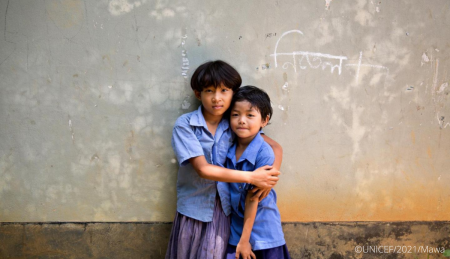You are here
Addressing child protection concerns through the integration of social service workers in schools

 A new technical note, developed by the Global Social Service Workforce Alliance and UNICEF, finds that violence against children and other child protection concerns can be addressed more effectively when social service workers are integrated into school structures.
A new technical note, developed by the Global Social Service Workforce Alliance and UNICEF, finds that violence against children and other child protection concerns can be addressed more effectively when social service workers are integrated into school structures.
“Children spend a significant amount of time each day in school, making it a space where child protection concerns often present themselves, and giving school-based staff a vital frontline role in identification and response,” explains Stephen Blight, Senior Advisor for Child Protection at UNICEF.
“When appropriately capacitated, resourced and supported, social service workers located in or working with schools can play a major role in addressing concerns related to violence, abuse and neglect, mental health, and psychosocial well-being,” Blight continues.
The technical note, which included a review of evidence across the globe, finds that teachers and school administrators usually have primary responsibility for reporting child protection concerns, but in many countries, they do not have the training and support, or time, to recognize signs and symptoms of abuse or violence, to record concerns, or to make referrals. In fact, studies have shown that teachers in different contexts tend to under-report child abuse due to lack of knowledge about the signs and symptoms of abuse, unclear reporting procedures and fear of making inaccurate reports.
While it is recommended that teacher and administrator training and support remain a central component of child protection within schools, child protection and well-being concerns can be addressed more effectively if the responsibility is shared with social service workers. Properly trained and supported social service workers can work with teachers and administrators to establish an overall protective climate and culture in schools that is safe, non-violent and inclusive. They can also provide intensive and specialized support for at-risk students. They can also connect interventions at school with the wider child protection system and effectively follow-up on child protection concerns when making external referrals and collaborating with other agencies.
Research for this technical note found that over 50 countries in different parts of the world have a designated role of school social worker, but they use very different models of school social work. In the United Arab Emirates, all public schools have assigned social workers, at two levels: a social worker handles promotive and preventative work and manages ‘low-risk’ issues, while ‘high-risk’ issues are referred to a child protection specialist who has the legal authority to visit homes and intervene to protect a child from imminent danger. In Ecuador, the “Departamentos de Consejeria Estudiantil”, or DECE, work within educational institutions to ensure the protection and well-being of students. DECEs are composed of interdisciplinary teams, which include social workers, and have the responsibility to provide referrals and follow-up for students affected by violence within the school and/or community. In Mongolia, a provision for school social work was included in the ‘Law on Child Protection’ when it was amended in 2003. The ministry of education produced a job description for school social workers, assigning them a range of duties that include policy development, provision of parenting education, assessment and referrals, counselling, response to domestic violence allegations and more general family welfare tasks.
In other contexts, the key source of support for students is the role of school-based counsellor. In many countries, this role has expanded from supporting students’ academic and career development, to incorporate supporting students’ mental health and well-being. For example, in Jordan, the role of school-based counsellor includes running mental health programs for children and providing follow-up for cases of children found to be particularly at risk. In Bhutan, the ministry of education builds the capacity of school counsellors by equipping them with the knowledge and skills to prevent, recognize and respond to violence against children. Efforts are also being made to integrate child protection in residential schools, monasteries and nunneries where children live and learn, to ensure that children who are particularly vulnerable, because they are living outside of parental care, are not overlooked.
Unfortunately, a majority of low- and middle-income countries currently lack long-term programmes for involving the social service workforce in schools, whether that be as school social workers or school counsellors. In such countries, there is a need to advocate for the social service workforce to become integrated within schools, and for the key role that the social service workforce can play in schools to be recognized by ministries of education. Ministries of social welfare and ministries of education also need to work together to ensure the integration of the workforce within education. They should combine their efforts to ensure that social service workers’ role in schools is formalized and reinforced through appropriate training, development of professional standards, and ensuring workers in these roles are licensed or certified. Legislation is also needed that defines and mandates the role of the social service workforce in schools.
Where there are few if any formal professional development programs for the social service workforce, and so a shortage of qualified social workers, social pedagogues of psychologists, staff or volunteers can be equipped to take on para professional social service roles in schools, through suitable on the job training and supervision. This can help build capacity for meeting students’ social and emotional needs and preventing violence in schools. The ‘barefoot social worker model’ introduced in China, is one such example, in which local community members with a basic level of education and knowledge of social work and child protection, are trained and supported to provide essential, community-based child welfare services.
